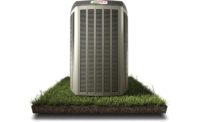I’ll admit, we weren’t the first to hop on the ProPress train when it pulled into the station, but it has been a game changer in the hydronic industry in ways that only a few technologies can compare.
That’s especially hard for me to admit because we’re a company that strives to stay on the cutting edge with new technology.
My thinking was something like this: It costs a lot, may not be all it’s claimed to be, and looks to be pretty involved (learning curve), so maybe the thing to do is to sit on the sidelines for a while to see how it does. Soon, there was broad use of technology we weren’t familiar with, and I began to sense that some of our competitors had an advantage.
I wanted in. And we’ve never regretted it.
TIME: OUR MOST VALUABLE ASSET
The key consideration is time. It’s finite, and I never, ever have enough of it. Our customers like the looks of it and are willing to pay for it (maybe with an explanation or two), and it saves loads of time. So ProPress technology has become as valuable to our work as anything in the toolbox.
But I want to be clear — ProPress will never replace the good ol’ “cut, clean, ream, Flux, and sweat,” but it’s a viable option to save time when it’s suited for the job.
Most press companies are even offering a black iron fitting option. Think of a long day of running gas lines without loading a threader and dies and not having to turn a pipe — not even once. That’ll cut the day in half.
We switched to ProPress to save time and produce as many installs as we can in the peak season. On top of that, most of the big manufacturers like Taco, Webstone, Watts, and Honeywell are offering ProPress zone valves, air separation, pump flanges, fill valves, backflow preventers, mixing valves, and purge stations. This is making life for installers far more efficient — to the tune of a 50 percent jump forward, in my opinion.
For me, the no-brainer advantages to this technology are so apparent. Less tangible benefits will become more apparent with use or through raw desire for them at moments like the one I’m about to describe (which I recall from an experience a month or so before making the investment).
One of my technicians was stuck deep within a crawlspace on a Friday at 6 p.m. He was trying to cut off a gate valve from the Stone Age, only to realize — after crawling for 10 minutes on his back to get in place — that he thought he was fully prepared to sweat-in its replacement.
No flux!
He has the tank of gas, emory paper, the right fitting, and the replacement valve, but as he was just about to grab the flux, a telemarketer’s call came through (now, there’s another frustration!). Needless to say, it was a disconnect that led to his predicament.
Had he grabbed the new gate valve, a box of fittings, and the ProPress tool, he’d have been on his way home.
And by the way, you can press a fitting with a trickle of water flowing through it when you’re using the ProPress.
OTHER CONSIDERATIONS
Here are a few things to take into consideration when considering the move to ProPress technology:
- Will your parts house stock enough fittings to keep you from delaying an install?
- Are you motivated to learn the process for proper use of the new technology and/or installation techniques?
- Marking the depth of your fittings before pressing will save you leaks and headaches, and you still have to ram-and-sand the pipe. I know, I know . . . that begs the question: What’s the point of pressing if you still have to do the legwork? You’ll have to trust me: It’s still much faster, safer, and cleaner. And of course, the hit-it-out-of-the-park potential is always there when a client sees it for the first time.
- Finally, be sure you like what you buy before you pull out the card — your investment could quickly top $15,000 or $20,000. So just ... be sure.
THE TOOLS
Today, there are so many manufactures that have stepped into the ProPress realm: Nibco, DeWalt, Ridgid, Reed, and Rothenberger — all with varying types of fittings and designs.
At this year’s AHR Expo in Chicago, we found that even GreenLee, an electrical tools manufacturer, is making a hydronic press tool!
I’m also fond of the Milwaukee Electric Tool Corp. m18 and m12 tools. Size, quality, and warranty made that decision for us. Plus, most of our techs and installers have Milwaukee cordless tools, so they can use the same batteries and chargers.
Most suppliers rent ProPress tools, so we’ll typically rent them and use them initially, trying as many brands and variations as possible so that we find the tool we like most.
So often, decisions like this boil down to personal preferences. It may be $2,800 or more for a single tool.
Our employees are loving the ProPress tools. Even our diehard veteran — who laughed when the tools and fittings started showing up to the shop — has taken to them.
It’s funny, actually ... now he’s the first to complain (while rolling his eyes at his own mistake) when he has to take a torch and soldering tray off the truck.
I can honestly say it’s changed the morale on job sites.
I’ll attempt to be objective about the tools with a few additional thoughts.
PROS
- Faster install times — by as much as 50 percent;
- Longer bend radius of the fittings, which means less friction loss — and with greater wall thickness, you’re using higher quality fittings; and
- Discounts on liability insurance, depending on providers.
CONS
- An average of 40 percent higher costs for fittings and valves;
- High upfront cost for tools; and
- Availability of press fittings.
IN HINDSIGHT
The switch to ProPress is a very big decision to make, no matter the size of your company. With proper education, research, and patience, it can be a seamless transition. It’s similar to the big change from paper invoices to digital; it takes getting used to.
But in the long run — with substantially lower install times, safer and happier technicians, job sites that look like mechanical art, and an improved profitability — you’re almost certain to wish you’d made the switch years earlier.
Publication date: 11/12/2018
Want more HVAC industry news and information? Join The NEWS on Facebook, Twitter, and LinkedIn today!





